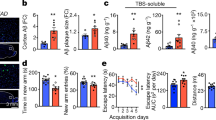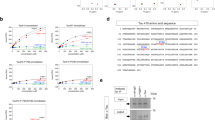Abstract
Astrocytes actively participate in synaptic integration by releasing transmitter (glutamate) via a calcium-regulated, exocytosis-like process. Here we show that this process follows activation of the receptor CXCR4 by the chemokine stromal cell-derived factor 1 (SDF-1). An extraordinary feature of the ensuing signaling cascade is the rapid extracellular release of tumor necrosis factor-α (TNFα). Autocrine/paracrine TNFα-dependent signaling leading to prostaglandin (PG) formation not only controls glutamate release and astrocyte communication, but also causes their derangement when activated microglia cooperate to dramatically enhance release of the cytokine in response to CXCR4 stimulation. We demonstrate that altered glial communication has direct neuropathological consequences and that agents interfering with CXCR4-dependent astrocyte–microglia signaling prevent neuronal apoptosis induced by the HIV-1 coat glycoprotein, gp120IIIB. Our results identify a new pathway for glia–glia and glia–neuron communication that is relevant to both normal brain function and neurodegenerative diseases.
This is a preview of subscription content, access via your institution
Access options
Subscribe to this journal
Receive 12 print issues and online access
$209.00 per year
only $17.42 per issue
Buy this article
- Purchase on Springer Link
- Instant access to full article PDF
Prices may be subject to local taxes which are calculated during checkout






Similar content being viewed by others
References
Haydon, P. G. Glia: listening and talking to the synapse. Nat. Reviews Neurosci. 2, 185–193 (2001).
Bezzi, P. & Volterra, A. A neuron–glia signalling network in the active brain. Curr. Opin. Neurobiol. 11, 387–394 (2001).
Porter, J. T. & McCarthy, K. D. Hippocampal astrocytes in situ respond to glutamate released from synaptic terminals. J. Neurosci. 16, 5073–5081 (1996).
Pasti, L., Volterra, A., Pozzan, T. & Carmignoto, G. Intracellular calcium oscillations in astrocytes: a highly plastic, bi-directional form of communication between neurons and astrocytes in situ. J. Neurosci. 17, 7817–7830 (1997).
Kang, J., Jiang, L., Goldman, S. A. & Nedergaard, M. Astrocyte-mediated potentiation of inhibitory synaptic transmission. Nat. Neurosci. 1, 683–692 (1998).
Grosche, J. et al. Microdomains for neuron–glia interaction: parallel fiber signaling to Bergmann glial cells. Nat. Neurosci. 2, 139–143 (1999).
Parpura, V. et al. Glutamate-mediated astrocyte-neuron signalling. Nature 369, 744–747 (1994).
Bezzi, P. et al. Prostaglandins stimulate calcium-dependent glutamate release in astrocytes. Nature 391, 281–285 (1998).
Araque, A., Li, N., Doyle, R. T. & Haydon, P. G. SNARE protein-dependent glutamate release from astrocytes. J. Neurosci. 20, 666–673 (2000).
Pasti, L., Zonta, M., Pozzan, T., Vicini, S. & Carmignoto, G. Cytosolic calcium oscillations in astrocytes may regulate exocytotic release of glutamate. J. Neurosci. 21, 477–484 (2001).
Araque, A., Parpura, V., Sanzgiri, R. P. & Haydon, P. G. Glutamate-dependent astrocyte modulation of synaptic transmission between cultured hippocampal neurons. Eur. J. Neurosci. 10, 2129–2142 (1998).
Araque, A., Sanzgiri, R., Parpura, V. & Haydon, P. G. Calcium elevation in astrocytes causes an NMDA receptor-dependent increase in the frequency of miniature synaptic currents in cultured hippocampal neurons. J. Neurosci. 18, 6822–6829 (1998).
Newman, E. & Zahs, K. R. Modulation of neuronal activity by glial cells in the retina. J. Neurosci. 18, 4022–4028 (1998).
Robitaille, R. Modulation of synaptic efficacy and synaptic depression by glial cells at the frog neuromuscular junction. Neuron 21, 847–855 (1998).
Rossi, D. & Zlotnik, A. The biology of chemokines and their receptors. Annu. Rev. Immunol. 18, 217–242 (2000).
Asensio, V. C. & Campbell, I. L. Chemokines in the CNS: plurifunctional mediators in diverse states. Trends Neurosci. 22, 504–512 (1999).
Miller, R. J. & Meucci, O. AIDS and the brain: is there a chemokine connection? Trends Neurosci. 22, 471–479 (1999).
Nagasawa, T., Tachibana, K. & Kawabata, K. A CXC chemokine SDF-1/PBSF: a ligand for a HIV coreceptor, CXCR4. Adv. Immunol. 71, 211–228 (1998).
Zou, Y-R., Kottman, A. H., Kuroda, M., Taniuchi, I. & Littman, D. R. Function of the chemokine receptor CXCR4 in hematopoiesis and in cerebellar development. Nature 393, 595–598 (1998).
Zheng, J. et al. Intracellular CXCR4 signalling, neuronal apoptosis and neuropathogenic mechanisms of HIV-1-associated dementia. J. Neuroimmunol. 98, 185–200 (1999).
Zheng, J. et al. Lymphotropic virions affect chemokine receptor-mediated neural signalling and apoptosis: implications for human immunodeficiency virus type 1-associated dementia. J. Virol. 73, 8256–8267 (1999).
Limatola, C. et al. SDF-1α-mediated modulation of synaptic transmission in rat cerebellum. Eur. J. Neurosci. 12, 2497–2504 (2000).
Kaul, M., Garden, G. A. & Lipton, S. A. Pathways to neuronal injury and apoptosis in HIV-associated dementia. Nature 410, 988–994 (2001).
Rossi, D. J., Oshima, T. & Attwell, D. Glutamate release in severe brain ischemia is mainly by reversed uptake. Nature 403, 316–321 (2000).
Endres, M. J. et al. CD4 independent infection by HIV-2 is mediated by fusin/CXCR4. Cell 87, 745–756 (1996).
Donzella, G. A. et al. AMD3100, a small molecule inhibitor of HIV-1 entry via the CXCR4 co-receptor. Nat. Med. 4, 72–77 (1998).
Pasparakis, M., Alexopoulou, L., Episkopou, V. & Kollias, G. Immune and inflammatory responses in TNFα-deficient mice: a critical requirement for TNFα in the formation of primary B cell follicles, follicular dendritic cell networks and germinal centers, and in the maturation of the humoral immune response. J. Exp. Med. 184, 1397–1411 (1996).
Kriegler, M., Perez, C., DeFay, K., Albert, I. & Lu, S. D. A novel form of TNF/cachectin is a cell surface cytotoxic transmembrane protein: ramifications for the complex physiology of TNF. Cell 53, 45–53 (1988).
Gearing, A. J. et al. Processing of tumor necrosis factor-alpha precursor by metalloproteinases. Nature 370, 555–557 (1994).
Favata, M. F. et al. Identification of a novel inhibitor of mitogen-activated protein kinase kinase. J. Biol. Chem. 273, 18623–18632 (1998).
Benveniste, E. N. & Benos, D. J. TNF-α and IFN-γ-mediated signal transduction pathways: effects on glial cell gene expression and function. FASEB J. 9, 1577–1584 (1995).
Szatkowski. M., Barbour, B. & Attwell, D. Nonvesicular release of glutamate from glial cells by reversed electrogenic glutamate uptake. Nature 348, 443–446 (1990).
Kimelberg, H. K., Goderie, S. K., Higman, S., Pang, S. & Waniewski, R. A. Swelling-induced release of glutamate, aspartate and taurine from astrocyte cultures. J. Neurosci. 10, 1583–1591 (1990).
Giulian, D. & Baker, T. J. Characterization of ameboid microglia isolated from developing mammalian brain. J. Neurosci. 6, 2163–2178 (1986).
Dreyer, E. & Lipton, S. A. The coat protein gp120 of HIV-1 inhibits astrocyte uptake of excitatory amino acids via macrophage arachidonic acid. Eur. J. Neurosci. 7, 2502–2507 (1995).
Streit, W. in Neuroglia (eds. Kettenmann, H. & Ransom, B.R.) 85–96 (Oxford Univ. Press, New York, 1995).
Noda, M., Nakanishi, H., Nabekura, J. & Akaike, N. AMPA-kainate subtypes of glutamate receptor in rat cerebral microglia. J. Neurosci. 20, 251–258 (2000).
Toggas, S. M. et al. Central nervous system damage produced by expression of the HIV-1 coat protein gp120 in transgenic mice. Nature 367, 188–192 (1994).
Bagetta, G. et al. Involvement of interleukin-1β in the mechanism of human immunodeficiency virus type 1 (HIV-1) recombinant protein gp120-induced apoptosis in the neocortex of rat. Neuroscience 89, 1051–1066 (1999).
Hesselgesser, J. et al. CD4-independent association between HIV-1 gp120 and CXCR4: functional chemokine receptors are expressed in human neurons. Curr. Biol. 7, 112–121 (1997).
Braun, J. S. et al. Neuroprotection by a caspase inhibitor in acute bacterial meningitis. Nat. Med. 59, 298–302 (1999).
Futaki, N. et al. NS-398, a new anti-inflammatory agent selectively inhibits prostaglandin G/H synthase/cyclooxygenase 2 (COX-2) activity in vitro. Prostaglandins 47, 55–59 (1994).
Innocenti, B., Parpura, V. & Haydon, P. G. Imaging extracellular waves of glutamate during calcium signalling in cultured astrocytes. J. Neurosci. 20, 1800–1808 (2000).
Guthrie, P. B. et al. ATP released from astrocytes mediates glial calcium waves. J. Neurosci. 19, 520–528 (1999).
Genis, P. et al. Cytokines and arachidonic metabolites produced during human immunodeficiency virus (HIV)-infected macrophage–astroglia interactions: implications for the neuropathogenesis of HIV disease. J. Exp. Med. 176, 1703–1718 (1992).
Fine, S. M. et al. Tumor Necrosis Factor α inhibits glutamate uptake by primary human astrocytes. J. Biol. Chem. 271, 15303–15306 (1996).
Meda, L. et al. Activation of microglial cells by β-amyloid protein and interferon-γ. Nature 374, 647–650 (1995).
Vescovi, A. L. et al. Isolation and cloning of multipotential stem cells from the embryonic human CNS and establishment of transplantable human neural stem cell lines by epigenetic stimulation. Exp. Neurol. 156, 71–83 (1999).
Abele, A. E., Scholz, K. P., Scholz, W. K. & Miller, R. J. Excitotoxicity induced by enhanced excitatory neurotransmission in cultured hippocampal pyramidal neurons. Neuron 4, 413–419 (1990).
Davis, C. B. et al. Signal transduction due to HIV-1 envelope interactions with chemokine receptors CXCR4 or CCR5. J. Exp. Med. 186, 1793–1798 (1997).
Acknowledgements
This work was supported by grants from European Community (QLK6-CT1999-02203), Ministero Università e Ricerca Scientifica e Tecnologica of Italy (Cofin 1998-1999 and 2000-2001), Telethon-Italy (754) to A.V., Istituto Superiore di Sanita of Italy (II National Program on AIDS Research, 2/264; National Program on Alzheimer's Disease) to J.M. and European Fund for regional development (Calabria Region, POP 1994/99) to G.B. M.D. is the recipient of a post-doctoral fellowship from the Gobierno Vasco. We thank R. Paoletti, G. Racagni and S. Nicosia for support and advice; A. Pandiella, S. Vesce and P. Panzarasa for their contributions during the early phases of the project; C. Del Duca, S. Piccirilli, A. Pietropoli, E. Pilati, P. Podini, G. Racchetti, M. Treccozzi and C. Valori for their help with experiments; ALEMBIC, San Raffaele Scientific Institute, Milan, for confocal microscopy images; C. Montecucco for supplying purified tetanus neurotoxin; British Biotech Pharmaceuticals for their gift of BB3103; and D. Dunlap for the revision of the text. M. Baggiolini, D. Littman, P. Lusso, G. Poli and A. Malgaroli for commentson previous versions of the manuscript.
Author information
Authors and Affiliations
Corresponding author
Rights and permissions
About this article
Cite this article
Bezzi, P., Domercq, M., Brambilla, L. et al. CXCR4-activated astrocyte glutamate release via TNFα: amplification by microglia triggers neurotoxicity. Nat Neurosci 4, 702–710 (2001). https://doi.org/10.1038/89490
Received:
Accepted:
Issue Date:
DOI: https://doi.org/10.1038/89490
This article is cited by
-
Understanding immune microenvironment alterations in the brain to improve the diagnosis and treatment of diverse brain diseases
Cell Communication and Signaling (2024)
-
Effects of fetal growth restriction on the perinatal neurovascular unit and possible treatment targets
Pediatric Research (2024)
-
CREB1-driven CXCR4hi neutrophils promote skin inflammation in mouse models and human patients
Nature Communications (2023)
-
TGF-β Activated Kinase 1 (TAK1) Is Activated in Microglia After Experimental Epilepsy and Contributes to Epileptogenesis
Molecular Neurobiology (2023)
-
Targeted Therapy of Spinal Cord Injury: Inhibition of Apoptosis Is a Promising Therapeutic Strategy
Molecular Neurobiology (2023)



